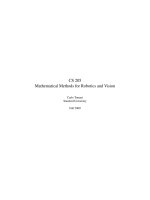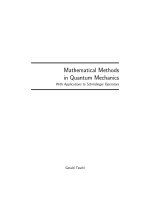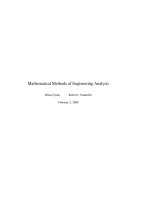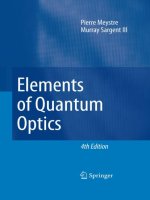- Trang chủ >>
- Khoa Học Tự Nhiên >>
- Vật lý
Mathematical methods of quantum optics
Bạn đang xem bản rút gọn của tài liệu. Xem và tải ngay bản đầy đủ của tài liệu tại đây (4.11 MB, 303 trang )
R.R.Puri
MATHEMATICAL METHODS OF QUANTUM OPTICS
Berlin: Springer, 2001, pp. XIII+285
This book provides an accessible introduction to the mathematical methods of
quantum optics. Starting from first principles, it reveals how a given system of atoms
and a field is mathematically modelled. The method of eigenfunction expansion and the
Lie algebraic method for solving equations are outlined. Analytically exactly solvable
classes of equations are identified. The text also discusses consequences of Lie
algebraic properties of Hamiltonians, such as the classification of their states as
coherent, classical or non-classical based on the generalized uncertainty relation and the
concept of quasiprobability distributions. A unified approach is developed for
determining the dynamics of two-level and a three- level atom in combinations of
quantized fields under certain conditions. Simple methods for solving a variety of linear
and nonlinear dissipative master equations are given.
Contents
1. Basic Quantum Mechanics
1
1.1 Postulates of Quantum Mechanics
1
1.1.1 Postulate 1
1
1.1.2 Postulate 2
11
1.1.3 Postulate 3
11
1.1.4 Postulate 4
11
1.1.5 Postulate 5
13
1.2 Geometric Phase
16
1.2.1 Geometric Phase of a Harmonic Oscillator
18
1.2.2 Geometric Phase of a Two-Level System
18
1.2.3 Geometric Phase in Adiabatic Evolution
18
1.3 Time-Dependent Approximation Method
19
1.4 Quantum Mechanics of a Composite System
20
1.5 Quantum Mechanics of a Subsystem and Density Operator
21
1.6 Systems of One and Two Spin-l/2s
23
1.7 Wave-Particle Duality
26
1.8 Measurement Postulate and Paradoxes of Quantum Theory
29
1.8.1 The Measurement Problem
30
1.8.2 Schrödinger's Cat Paradox
31
1.8.3 EPR Paradox
32
1.9 Local Hidden Variables Theory
34
2. Algebra of the Exponential Operator
37
2.1 Parametric Differentiation of the Exponential
37
2.2 Exponential of a Finite-Dimensional Operator
38
2.3 Lie Algebraic Similarity Transformations
39
2.3.1 Harmonic Oscillator Algebra
41
2.3.2 The SU(2) Algebra
42
2.3.3 The SU(1,1) Algebra
43
2.3.4 The SU(m) Algebra
45
2.3.5 The SU(m, n) Algebra
2.4 Disentangling an Exponential
2.4.1 The Harmonic Oscillator Algebra
2.4.2 The SU(2) Algebra
2.4.3 SU(1,1) Algebra
2.5 Time-Ordered Exponential Integral
2.5.1 Harmonic Oscillator Algebra
2.5.2 SU(2) Algebra
2.5.3 The SU(1, 1) Algebra
3. Representations of Some Lie Algebras
3.1 Representation by Eigenvectors and Group Parameters
3.1.1 Bases Constituted by Eigenvectors
3.1.2 Bases Labeled by Group Parameters
3.2 Representations of Harmonic Oscillator Algebra
3.2.1 Orthonormal Bases
3.2.2 Minimum Uncertainty Coherent States
3.3 Representations of SU(2)
3.3.1 Orthonormal Representation
3.3.2 Minimum Uncertainty Coherent States
3.4 Representations of SU(1, 1)
3.4.1 Orthonormal Bases
3.4.2 Minimum Uncertainty Coherent States
4. Quasiprobabilities and Non-classical States
4.1 Phase Space Distribution Functions
4.2 Phase Space Representation of Spins
4.3 Quasiprobabilitiy Distributions for Eigenvalues of Spin Components
4.4 Classical and Non-classical States
4.4.1 Non-classical States of Electromagnetic Field
4.4.2 Non-classical States of Spin-l/2s
5. Theory of Stochastic Processes
5.1 Probability Distributions
5.2 Markov Processes
5.3 Detailed Balance
5.4 Liouville and Fokker-Planck Equations
5.4.1 Liouville Equation
5.4.2 The Fokker-Planck Equation
5.5 Stochastic Differential Equations
5.6 Linear Equations with Additive Noise
5.7 Linear Equations with Multiplicative Noise
5.7.1 Univariate Linear Multiplicative Stochastic Differential Equations
5.7.2 Multivariate Linear Multiplicative Stochastic Differential Equations
5.8 The Poisson Process
5.9 Stochastic Differential Equation Driven by Random Telegraph Noise
6. The Electromagnetic Field
www.pdfgrip.com
45
48
49
50
51
52
52
53
53
55
55
55
56
60
60
61
68
68
70
76
76
77
81
81
88
93
95
95
97
99
99
102
105
106
107
107
109
110
112
113
114
115
116
119
6.1 Free Classical Field
6.2 Field Quantization
6.3 Statistical Properties of Classical Field
6.3.1 First-Order Correlation Function
6.3.2 Second-Order Correlation Function
6.3.3 Higher-Order Correlations
6.3.4 Stable and Chaotic Fields
6.4 Statistical Properties of Quantized Field
6.4.1 First-Order Correlation
6.4.2 Second-Order Correlation
6.4.3 Quantized Coherent and Thermal Fields
6.5 Homodyned Detection
6.6 Spectrum
7. Atom— Field Interaction Hamiltonians
7.1 Dipole Interaction
7.2 Rotating Wave and Resonance Approximations
7.3 Two-Level Atom
7.4 Three-Level Atom
7.5 Effective Two-Level Atom
7.6 Multi-channel Models
7.7 Parametric Processes
7.8 Cavity QED
7.9 Moving Atom
8. Quantum Theory of Damping
8.1 The Master Equation
8.2 Solving a Master Equation
8.3 Multi-Time Average of System Operators
8.4 Bath of Harmonic Oscillators
8.4.1 Thermal Reservoir
8.4.2 Squeezed Reservoir
8.4.3 Reservoir of the Electromagnetic Field
8.5 Master Equation for a Harmonic Oscillator
8.6 Master Equation for Two-Level Atoms
8.6.1 Two-Level Atom in a Monochromatic Field
8.6.2 Collisional Damping
8.7 Master Equation for a Three-Level Atom
8.8 Master Equation for Field Interacting with a Reservoir of Atoms
9. Linear and Nonlinear Response of a System in an External Field
9.1 Steady State of a System in an External Field
9.2 Optical Susceptibility
9.3 Rate of Absorption of Energy
9.4 Response in a Fluctuating Field
10. Solution of Linear Equations: Method of Eigenvector Expansion
10.1 Eigenvalues and Eigenvectors
www.pdfgrip.com
119
121
123
125
126
126
127
130
131
132
132
134
135
137
137
140
144
145
146
149
150
151
153
155
155
160
162
163
164
166
167
168
170
171
172
173
174
177
177
179
181
183
185
186
10.2 Generalized Eigenvalues and Eigenvectors
10.3 Solution of Two- Term Difference-Differential Equation
10.4 Exactly Solvable Two- and Three-Term Recursion Relations
10.4.1 Two- Term Recursion Relations
10.4.2 Three- Term Recursion Relations
11. Two-Level and Three-Level Hamiltonian Systems
11.1 Exactly Solvable Two-Level Systems
11.1.1 Time-Independent Detuning and Coupling
11.1.2 On- Resonant Real Time-Dependent Coupling
11.1.3 Fluctuating Coupling
11.2 N Two-Level Atoms in a Quantized Field
11.3 Exactly Solvable Three- Level Systems
11.4 Effective Two-Level Approximation
12. Dissipative Atomic Systems
12.1 Two-Level Atom in a Quasimonochromatic Field
12.1.1 Time-Dependent Evolution Operator Reducible to SU(2)
12.1.2 Time-Independent Evolution Operator
12.1.3 Nonlinear Response in a Dichromatic Field
12.2 N Two-Level Atoms in a Monochromatic Field
12.3 Two-Level Atoms in a Fluctuating Field
12.4 Driven Three-Level Atom
13. Dissipative Field Dynamics
13.1 Down-Conversion in a Damped Cavity
13.1.1 Averages and Variances of the Cavity Field Operators
13.1.2 Density Matrix
13.2 Field Interacting with a Two-Photon Reservoir
13.2.1 Two-Photon Absorption
13.2.2 Two-Photon Generation and Absorption.
13.3 Reservoir in the Lambda Configuration
14. Dissipative Cavity QED
14.1 Two-Level Atoms in a Single-Mode Cavity
14.2 Strong Atom-Field Coupling
14.2.1 Single Two-Level Atom.
14.3 Response to an External Field
14.3.1 Linear Response to a Monochromatic Field
14.3.2 Nonlinear Response to a Bichromatic Field
14.4 The Micromaser
14.4.1 Density Operator of the Field
14.4.2 Two-Level Atomic Micromaser
14.4.3 Atomic Statistics
Appendices
A. Some Mathematical Formulae
B. Hypergeometric Equation
C. Solution of Two-and Three-Dimensional Linear Equations
www.pdfgrip.com
189
191
192
192
193
199
199
202
208
208
210
210
212
215
215
217
219
223
224
236
237
239
239
240
242
245
245
247
248
251
251
252
252
255
256
257
259
259
263
266
267
267
270
272
D. Roots of a Polynomial
References
Index
273
277
283
Index
absorption spectrum 182
ac Stark splitting 223
algebra
- harmonic oscillator 41
- SU(1,1) 43
- SU(2) 42
- SU(m) 44
- SU(m,n) 45
antibunching 132
antinormal ordering 49, 83
Bargmann representation 64
Bell's inequality 35
Bloch-Siegert shift 142
Bloembergen resonances 224
Born approximation 157
bunching 134
cat paradox 31
cavity QED 151
Chapman-Kolmogorov equation 103
characteristic function 100
coherent multiphoton process 148
coherent states 58
- generalized 57
- Glauber 58,62
- of e.m. field 58, 133
- of harmonic oscillator 62
- of spins 70
- of SU(2) 70
- pair 78, 248
- Perelomov 57
coherent states, completeness relation
57
- for harmonic oscillator 62
- for SU(1,1) 78
- for SU(2) 72
coherent states, minimum uncertainty
59
- of harmonic oscillator 64
- of spins 70, 72
- of SU(1,1) 77
coherent states, uncorrelated equal
variance minimum uncertainty 59
- of harmonic oscillator 62
- of spins 70
- of SU(1,1) 77
collapses and revivals 206
collisional damping 172
complementarity 12,27
cumulants 101
density operator 21
Descarte's rule 277
detailed balance 106, 108, 160, 225
differentiation, parametric 8
- of exponential operator 37
- of operator product 8
disentangling an exponential 48
- harmonic oscillator algebra 49
- SU(1,1) algebra 51
- SU(2) algebra 50
down conversion 151,239
dressed states 204
e.m. field
- chaotic, classical 127
- chaotic, quantum 133
- coherence time 130
- coherent 127,133
- correlation functions, classical 123
- correlation functions, quantum 130
- quantization 121
effective two-level approximation 212
effective two-level atom 147
eigenvalue 7,186
- generalized 189
eigenvector 7,186
- generalized 189
entangled state 20, 25
EPR Paradox 32
equal variance minimum uncertainty
state 13
Fokker-Planck equation 107
www.pdfgrip.com
four-wave mixing 223, 257
- collision induced resonances 224, 257
- quantum resonances 258
Gaussian process 102
geometric phase 16
- in adiabatic evolution 18
- of a harmonic oscillator 18
- of a two-level system 18
Hamilton-Cayley theorem 190
Heisenberg equation 14
hidden variables theory 34
- local 34
Hilbert space 1
homodyned detection 134
Hurwitz criterion 277
Husimi function 87
incompatibility 12
interaction picture 15
interference 26,27
Jaynes-Cummings model 143, 144, 204
Jordan canonical form 189
Lie algebra 40
Lie group 56
Markov approximation 158
Markov process 103
master equation 104, 105, 158
measurement problem 30
micromaser 259
- trapping condition 264
minimum uncertainty states 12, 59
- of harmonic oscillator 61, 67
- of spins 70
- of 5E7(M) 77
mixed state 22
moments 100
multi time joint probability 15
multi-channel models 149
noise
- additive 110
- coloured 109
- delta correlated 109
- Gaussian white 109
- multiplicative 110, 112
- white 109
non-classical states 95
- of e.m. field 95
- ofspin-l/2s 97
normal ordering 49, 83
Ornstein-Uhlenbeck process 110-112
P-function 86
- for spins 91
parametric processes 150
phase
- dynamic 16
- geometric (see geometric phase) 16
photon 122
Poisson process 115
probability amplitude 11
probability density 11,99
- conditional 103
- joint 99
pure state 22
Q-function 87
- for spins 92
quantum eraser 29
quasiprobability distribution 83
- for spins 89
Rabi frequency 142, 221
random telegraph noise 116
regression theorem 105,163
representations
- by eigenvectors 55
- equivalent 56
- labeled by group parameters 56
- of harmonic oscillator algebra 60
- of SU(1,1) algebra 76
- of SU(2) algebra 68
resonance approximation 144
resonance fluorescence 171, 219
- collective 225
rotating wave approximation 143, 181
Rydberg atom 152
s-ordering 83
Schmidt decomposition 25
Schrödinger equation 13
Schwarz inequality 2
- generalized 3
www.pdfgrip.com
secular approximation 162, 227, 253,
256
semiclassical approximation 139
similarity transformation 39
- harmonic oscillator 41
- SU(1,1) 43
- SU(2) 42
- SU(m) 44
- SU(m,n) 45
Sneddon's formula 37
spectroscopic squeezing 75
spectrum 136
- absorption 223,256
- emission 222 spin operators
- collective 69
- lowering 23
- raising 23
squeezed reservoir 166
squeezed states
- of harmonic oscillator 67
- of spins 73, 74
squeezed vacuum 166
squeezing operator 65
Stark shift 214
stationary process 100
stochastic differential equation 109
sub-Poissonian distribution 132
superoperator 10
- adjoint 10
superposition, principle of 26
susceptibility 179
- optical 180 symmetric ordering 83
- for spins 94
thermal reservoir 164 three level atom
145
time-ordered exponential integration
- harmonic oscillator algebra 52
- SU(1,1) algebra 53
- SU(2) algebra 53
trace 6
transition probability 103
two-channel Raman-coupled model
150, 207
two-level atom 144
two-photon process 146
two-photon reservoir
- in ladder configuration 245
- in Lambda configuration 248
uncertainty relation 12
uncorrelated equal variance minimum
uncertainty state 13, 62
vacuum field Rabi oscillations 205
vacuum field Rabi splitting 257
vacuum fluctuations 122
wave mixing 149, 181
wave-particle duality 26
welcher weg 28
which path 28
Wiener process 110, 111
Wiener-Khintchine theorem 136
Wigner function 87
- for spins 92
Zeno effect 16
www.pdfgrip.com
www.pdfgrip.com
www.pdfgrip.com
www.pdfgrip.com
www.pdfgrip.com
www.pdfgrip.com
www.pdfgrip.com
www.pdfgrip.com
www.pdfgrip.com
www.pdfgrip.com
www.pdfgrip.com
www.pdfgrip.com
www.pdfgrip.com
www.pdfgrip.com
www.pdfgrip.com
www.pdfgrip.com
www.pdfgrip.com
www.pdfgrip.com
www.pdfgrip.com









